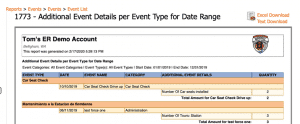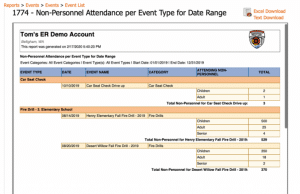What is NFPA 1300 and Why Should You Care?
NFPA 1300 is the standard for community risk assessment and community risk reduction plan development. In practice, NFPA 1300 provides guidance on conducting a community risk assessment (CRA), creating and implementing a community risk reduction (CRR) plan, and establishing ongoing evaluation of that plan.
WHY SHOULD YOU CARE?
According to the National Fire Protection Association, NFPA 1300 helps a broad range of authorities determine what kind of emergencies are occurring in their community, where, and to whom. NFPA 1300 provides the framework for building a CRR team, fostering strategic partnerships, and applying data to conduct both CRA and CRR activities.
WHAT IS COMMUNITY RISK REDUCTION?
Community risk reduction is a process that helps identify and prioritize risks that a community faces, and emphasizes the integrated and strategic investment of resources to reduce their occurrence and impact on the community. In other words, it is a process to help communities determine what their risks are and develop a plan to reduce the risks viewed as high priority. The steps involved in community risk reduction are as follows:
- Conduct a Community Risk Assessment (CRA)
- Develop a CRR plan
- Implement the plan
- Evaluate the effectiveness of the plan
CRR has gained traction in recent years. According to Lorraine Carli, vice president of Outreach and Advocacy at the National Fire Protection Association (NFPA), “CRR’s data-informed approach offers municipal leaders a vehicle for evaluating challenges, assigning accountability, and establishing transparency across agencies at a time when officials are struggling with budget woes, questions about data, and a host of emerging issues. NFPA 1300 serves as a springboard for local leaders to have conversations and take action.”
COMMUNITY RISK ASSESSMENT
The purpose of the community risk assessment is to evaluate a community’s risks prior to the development and implementation of a CRR plan and programs to reduce, mitigate, or eliminate the community’s risks. The CRA should include, but not be limited to, the following profiles to describe the community:
- Demographic
- Geographic
- Building stock
- Public safety response agencies
- Community service organizations
- Hazards
- Economic
- Past loss/event history
- Critical infrastructure systems
A critical component of the CRA is to determine what’s causing the most prominent risks that are impacting a community. With this information, you can develop a CRR plan to reduce, mitigate, or eliminate those risks. A useful tool for determining the cause of any problem is the “5 Whys” approach to root cause analysis.
THE 5 WHYS:
The “5 Whys” is a process that involves repeatedly asking “Why?”, with the goal of getting to the root cause of a problem. Typically, one can determine the root cause by asking “Why?” five times, although it could take more or less. For example, suppose there has been a rise in individuals suffering fire-related injuries in an apartment building. You could ask:
- Why? The smoke alarms are not providing early detection and warning.
- Why? Because the batteries are missing.
- Why? Because people have been removing the batteries from the alarms.
- Why? Because the alarms are causing nuisance warnings.
- Why? Because the alarms are installed in the wrong locations.
The answer to the fifth “Why?” is the root cause of the rise in fire-related injuries. Therefore, the strategy for risk reduction is to reinstall the alarms in the correct locations. This method can be used to get to the root cause of any problem.
MEASURING YOUR RESULTS
Once the CRA is complete and the CRR plan has been developed and implemented, it’s time to evaluate the effectiveness of the plan. Methods of data collection will vary depending on the CRR plan being executed. Typical data collection methods include, but are not limited to, the following:
- Counting numbers of attendees of a program
- Counting numbers of inspections conducted
- Pre- and post-test comparisons
- Random quality assessment surveys
- Customer or participant surveys
- Presenter evaluations from attendees
An annual report of the CRR plan should be prepared and presented for review to the appropriate agencies, departments, and employees having designated responsibilities in the plan.
HOW TO USE ER TO COMPLY WITH NFPA 1300
Emergency Reporting offers a multitude of reports that can aid you and your department in complying with NFPA 1300 and more importantly, keeping your community safe. We recommend checking out the following three reports:
1166 – HAZARD STATISTICS FOR ZONE
This report provides an excellent summary of the number of occupancies in each risk category along with a percentage and a chart to visualize the data. The key to this report is that it breaks it down by zone so you can easily assess each geographical area in your jurisdiction.

1773 – ADDITIONAL EVENT DETAILS PER EVENT TYPE FOR DATE RANGE
This report quickly provides a rundown of how many smoke detectors you’ve installed, car seats installed, station tours hosted, and other CRR performance indicators. To keep a CRR program going strong, you’ve got to have the data to demonstrate the value you’re providing. This report helps in a big way.


1774 – NON-PERSONNEL ATTENDANCE PER EVENT TYPE FOR DATE RANGE
A key metric for any CRR program is to be able to demonstrate your contacts with the community. This report provides an outstanding way to tell that story. Once you run this report you may be surprised at how many civilians you connect with each year as you make your communities safer.

About the Author:
 Tom Louis currently serves as a Business Development Analyst, Subject Matter Expert, and Key Account Manager for Emergency Reporting. He retired as a battalion chief from the Green Valley Fire District in Arizona in 2013 after serving for 22 years. He has used Emergency Reporting since 2004 and has been part of the Emergency Reporting family since 2011, working with customers throughout the United States and in Canada, South Korea, Japan, Germany, Italy, and Kuwait. He holds two associate degrees and graduated summa cum laude from Arizona State University with a bachelor of applied science degree in Fire Service Management. He believes that in order to tell a fire department’s story, high quality, actionable data in an easily understandable manner is essential for our communities and decision-makers. He is an avid reader of both non-fiction books and technothriller novels, loves classic and modern Mopar muscle cars, and has a soft spot for retired racing greyhounds.
Tom Louis currently serves as a Business Development Analyst, Subject Matter Expert, and Key Account Manager for Emergency Reporting. He retired as a battalion chief from the Green Valley Fire District in Arizona in 2013 after serving for 22 years. He has used Emergency Reporting since 2004 and has been part of the Emergency Reporting family since 2011, working with customers throughout the United States and in Canada, South Korea, Japan, Germany, Italy, and Kuwait. He holds two associate degrees and graduated summa cum laude from Arizona State University with a bachelor of applied science degree in Fire Service Management. He believes that in order to tell a fire department’s story, high quality, actionable data in an easily understandable manner is essential for our communities and decision-makers. He is an avid reader of both non-fiction books and technothriller novels, loves classic and modern Mopar muscle cars, and has a soft spot for retired racing greyhounds.
Sources:
https://www.nfpa.org/News-and-Research/Resources/Community-Risk-Reduction




